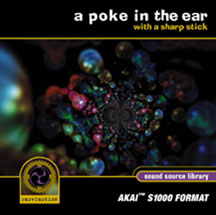Review by Carlos Garza
Originally Published in Pro Audio Review
Sound Design Tools Roundup
| This review examines three sound libraries designed for postproduction and multimedia effects and three libraries that have roughly equal value for dramatic sound design and contemporary music production.
The “Poke in the Ear…” series has been around for around for more than 10 years and includes three volumes of CD-ROM audio files, an audio CD compiled from volumes 1 and 2 and an AKAI S1000 disc compiled from all three volumes. I purchased an audio CD version 10 years ago and it has remained a favorite of mine. While the company is not producing new titles, they still offer all sets mentioned above. The S1000 disc is the subject of this review. I tested “A Poke in the Ear…” with an Akai S2000 sampler and Logic 7. In the latter case, I used the AKAI convert feature of EXS-24 to import programs and samples from the disc. Any DAW sampler engine or hardware sample player that supports the AKAI sample format should be capable of loading the set.  A Poke in the Ear with a Sharp Stick The sounds are grouped into percussive, metallic, “melodics,” environmental ambient, complex hits, machines, rhythm loops and voice. Most of the percussive programs are set up with each sample (mono or stereo) mapped to one MIDI note. The “melodics” have each sample spread across one or more octaves. The remaining programs have their samples spread across a major fifth (8 keys). While working through the 1200 sounds can take some time, especially on a hardware sample player, the ability to play many of the sounds across the range of a keyboard makes for an efficient workflow. I found the EXS-24 graphical editor a valuable resource in the absence of key mapping documentation. The set is not about musical instruments per se, but a few are included. The Syrian Tambourine is well recorded and features a variety of playing styles. However, the basic hits appear with only a single sample, which would lead to the “dreaded machine gun” effect if played repeatedly. Note that none of the programs use velocity layers or filtering. The other percussive sounds include large containers, bottles, jars, glass items, springs and a Slinky. There are some very useful and unusual percussion sounds here. The “tails” programs use a succession of sounds to build a sound phrase. One of my favorites is a sample called “Fever Dream.” I used the sound in a short horror film that I scored with Silent Orchestra, called Grave Consequences. The eerie dissonant high tones build to a high pitch rattle before resolving into monstrous breathing. “Poke” has quite a few sounds like this that work well in a musical track, especially a film score. Remember the sound a buzzing ruler on a desktop? It’s here in living stereo. Need the sound of adhesive tape being stretched and smacked? It’s here. Some of these sounds could work as Foley but the intention is to explore the sonic possibilities rather than common sounds. There are alien boings, whooshes and ambient soundscapes. The “cyberdoom” sounds include both hits and fade-ups — mostly metallic. Some of my favorites include the sounds of heavy things being dragged and abused, something that sounds like a chain saw from hell, low pulsing and throbbing sounds, squeaky wheels, glass cutting, electronic glitches and a few demonic voices. The rhythmic loops offer a lot of musical possibilities and some very unusual sounds combined into mechanical, world beats and out-of-this-world beats. It would be nice to have these in Garage Band or Acid format. This product lives up to its name with some very intense sounds. The metallic shrieks could be at home at just the right scene of a horror film or as background for a mechanical underwater disaster (think Poseidon). If you are looking for unobtrusive drones and beds, you’ve come to the wrong medieval castle. While there are a few drones, and some with low frequency effects the majority of this set is in your face (or ear). The “Pokes” sounds can be used for industrial rock, and sound design for sci-fi, horror, suspense, action adventure TV, films and games. If you are looking for things that go bump in the night, you will be hard pressed to find sounds this interesting for $29.95. Other formats are available for $49.95. Don’t let its age fool you. A Poke in the Ear still has some sharp teeth. Carlos Garza composes music for films. His work has been heard on Image Entertainment DVDs, Turner Classic Movies and the National Gallery of Art. He is a regular contributor to Pro Audio Review. All of the products reviewed in this article are offered by their respective manufacturers with a one-time purchase fee and no additional usage fees. (c) 2006 Carlos Garza |